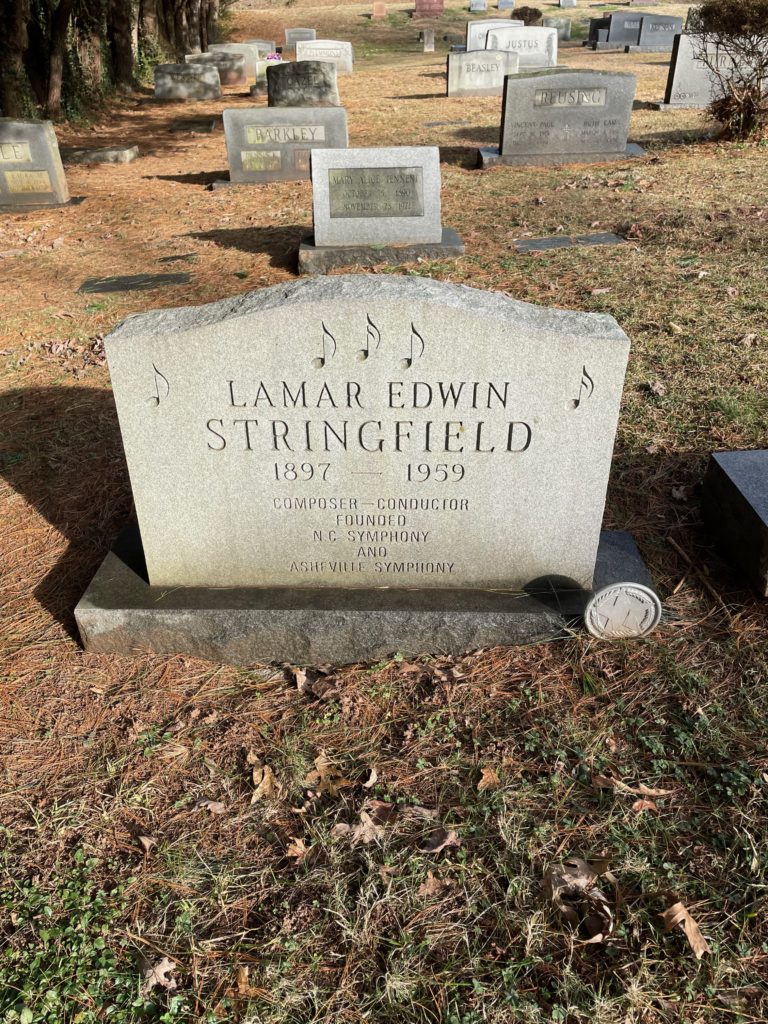Erik Visits an American Grave, Part 1,173
This is the grave of Lamar Stringfield.

Born in Raleigh, North Carolina in 1897, Stringfield grew up in the region as the son of a Baptist minister who had parishes through the western part of the state when young Lamar was a child. He went to Mars Hill College in Asheville and then to Wake Forest University. He was a flute player and a quite good one so that when World War I happened and Stringfield joined up, he was put in the band in France. Not a terrible way to spend the war, hanging out in Paris, playing flute, learning from the great musicians of that country. There was real work though too–the band members also carried stretchers to get the wounded off the battlefield, so he saw real action. He stayed on after the war as well, living in Paris and studying composition under Nadia Boulanger. There’s a lot of flutists out there, but there aren’t so many composers. He specialized in the composition of flute music and he brought that back home in 1920, when he co-founded the New York Flute Club with William Kincaid and Georges Barrère. Now, these are not widely known names today, but they were among the most important classical musicians of the time, which gets to the broader point that even though he was only 23, Stringfield was already seen as one of the nation’s premier flute masters. For what it is worth, the NYFC still exists today.
Stringfield himself is not per se a major figure in American music on the lines of Charles Ives or Aaron Copland or someone like that. But he was a regionally major figure and that’s important too. Stringfield’s major contribution was combining the regional folk music of his Appalachian home into his music. This was by no means uncommon during these years. Copland especially was fascinated by folk forms. He worked closely with the great old-timey fiddler Bascom Lunsford and they co-produced a set of string arrangements for folk songs in 1929. The next year, he founded the Institute of Folk Music at the University of North Carolina. But while he may not be as well-known as some of his contemporaries today, he did win the Pulitzer for Composition in 1928 for his work “From the Southern Mountains.”
Stringfield also went big time into conducting. He mostly lived in the South but occasionally worked in New York as well. He started what became the Asheville Symphony Orchestra in 1927 and then founded the North Carolina Sympathy in Chapel Hill in 1932, serving as its conductor until 1938. He got a gig that year as the associate conductor for Radio City Music Hall that lasted through the 1939 season. By this time, he was getting a ton of guest conducting appearances too, working sometimes with military bands, sometimes with pops-style orchestras, and sometimes with more traditional orchestras. He led both the Charlotte and Knoxville Symphony Orchestra at points in the late 40s. One may wonder if he would be better known today had he lived in New York and not Chapel Hill.
Yet another way Stringfield moved the music forward was getting involved in the creation of flutes, to the point of studying with physicists on how to maximize the instrument’s sound. He wanted to “do for the flute what Stradavari did for the violin,” to quote one scholar of the man. He opened what became a very well known flute shop in North Carolina where people would come to work on the highest end flutes.
In the end, Stringfield may not be among the most influential American classical musicians and composers of the 20th century. But maybe he should be. Let’s listen to some of his work:
Stringfield died in 1959, at the age of 61.
Lamar Stringfield is in Riverside Cemetery, Asheville, North Carolina.
If you would like this series to visit other American flutists, you can donate to cover the required expenses here. Buddy Collette is in Glendale, California and Yusef Lateef is in Sykesville, Maryland. Previous posts in this series are archived here.


